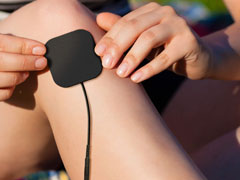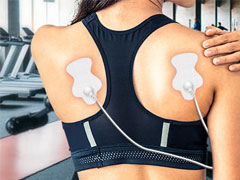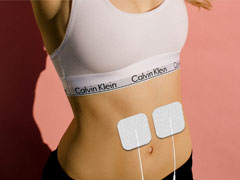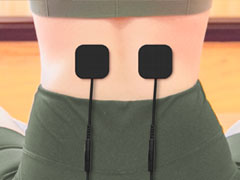
Transcutaneous electrical nerve stimulation (TENS) is a non-invasive method of pain relief that involves the use of electrodes to deliver low-frequency electrical impulses to the body. These impulses are thought to help block pain signals to the brain and promote the release of endorphins, which are natural painkillers produced by the body. TENS has been used to treat a wide range of conditions, including chronic pain, back pain, and arthritis. In this essay, we will explore the different types of electrodes used in TENS therapy.

1. Self-adhesive electrodes:
Self-adhesive electrodes are the most common type of electrode used in TENS therapy. These electrodes are typically made of a flexible material that conforms to the body's contours and is designed to adhere to the skin without the need for additional adhesives. Self-adhesive electrodes come in a variety of shapes and sizes and are designed to be used on different parts of the body, such as the back, neck, and legs. They are convenient to use, and they can be easily replaced when they lose their effectiveness.

2. Carbon electrodes:
Carbon electrodes are another type of electrode used in TENS therapy. These electrodes are made of carbon-impregnated silicone rubber and are designed to be used with conductive gel. Carbon electrodes are more conductive than self-adhesive electrodes, which makes them ideal for use on larger muscle groups, such as the thighs or shoulders. However, they can be more difficult to apply than self-adhesive electrodes, and they require the use of conductive gel, which can be messy and time-consuming.

3. Silver electrodes:
Silver electrodes are a less common type of electrode used in TENS therapy. These electrodes are made of a conductive silver layer that is bonded to a flexible substrate. Silver electrodes are highly conductive and are ideal for use in areas where a strong electrical current is required, such as the shoulders or hips. However, they are more expensive than self-adhesive or carbon electrodes, and they can be difficult to apply and remove.

4. Reusable electrodes:
Reusable electrodes are designed to be used multiple times and are typically made of a more durable material than self-adhesive electrodes. These electrodes can be used with conductive gel and are available in a variety of shapes and sizes to accommodate different body parts. Reusable electrodes are more expensive than self-adhesive electrodes, but they can be a more cost-effective option over time, as they can be used multiple times before needing to be replaced.

5. Disposable electrodes:
Disposable electrodes are designed for single-use and are typically made of a thin, flexible material that adheres to the skin without the need for additional adhesives. These electrodes are ideal for use in clinical settings, where hygiene is a concern. Disposable electrodes are more expensive than self-adhesive electrodes, but they offer the advantage of being easy to apply and dispose of, which can save time in a busy clinic or hospital setting.

Case Study: TENS therapy to manage her pain
Mrs. Jones is a 65-year-old woman who has been experiencing chronic lower back pain for several years. She has tried various pain medications, physical therapy, and chiropractic treatments, but nothing has provided long-term relief. Her doctor recommends that she try TENS therapy to manage her pain.
During her first TENS therapy session, Mrs. Jones is fitted with self-adhesive electrodes on her lower back. She reports a significant reduction in pain during the session and feels that the therapy is helping to alleviate her discomfort. However, after several sessions, she begins to notice that the self-adhesive electrodes are losing their effectiveness and are not adhering to her skin as well as they did initially.
At her next appointment, her therapist recommends trying carbon electrodes instead. The carbon electrodes are applied with conductive gel and are able to deliver a stronger electrical current to the muscles in her lower back. Mrs. Jones reports that she experiences immediate pain relief during the session and is pleased with the results.
After several weeks of using the carbon electrodes, Mrs. Jones begins to develop skin irritation from the conductive gel. Her therapist recommends switching to reusable electrodes, which are made of a more durable material and do not require the use of conductive gel. The reusable electrodes are able to provide sustained pain relief and are more cost-effective over time than the self-adhesive or carbon electrodes.
Overall, Mrs. Jones' experience with TENS therapy illustrates the importance of using the appropriate type of electrode for the individual patient's needs. The self-adhesive electrodes were effective initially but lost their effectiveness over time, while the carbon electrodes were able to deliver a stronger electrical current but caused skin irritation. The reusable electrodes provided a more comfortable and cost-effective solution in the long run. By working with her therapist to find the right type of electrode, Mrs. Jones was able to achieve significant pain relief and improve her quality of life.
In conclusion, there are several types of electrodes used in TENS therapy, including self-adhesive, carbon, silver, reusable, and disposable electrodes. Each type of electrode has its advantages and disadvantages, and the choice of electrode will depend on the individual patient's needs and the area of the body being treated. TENS therapy is a safe and effective way to manage pain, and the use of the appropriate electrode is an important factor in achieving the best possible outcomes.